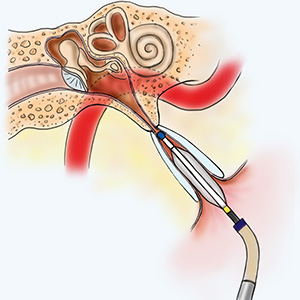Eustachian Tube Dysfunction
What is Eustachian tube dysfunction (ETD)?
ETD occurs when there is a dysfunction of the Eustachian tube. This condition prevents the release of pressure and fluid from the middle space (the space behind the tympanic membrane or ear drum). This can occur when there is increased swelling or fluid/mucus buildup at the opening of the Eustachian tube in the back of the nose. It can occur during common colds, upper respiratory tract infections, allergies, impeded nasal airflow or chronic drainage of mucus on the tube opening.
What is the Eustachian tube?
The Eustachian Tube (ET) is a small passage way that connects the middle ear to the nasopharynx. The tube is usually closed and opens when a person eats, swallows, yawns or attempts to “pop” his or her ears. The tube function to equalize the pressure between the ear and the surrounding environment. Therefore it helps prevent pressure and fluid from building up inside the ears.

What are the symptoms of ETD?
Common symptoms include:
- Ear pressure
- Hearing loss – ear feels plugged
- Popping sensation in the ears
- Ringing in ears, tinnitus
- Ear pain
- Dizziness on occasion
How is ETD diagnosed?
ETD can be diagnosed through a thorough head and neck examination. The physician will look in the ears to see the eardrum and into the nasal cavity. On many occasion, a good history can diagnose the condition as well. Another option is a hearing test (audiogram and tympanogram) to confirm the presence of negative pressure and/or fluid in the middle ear space.
How is it treated?
There are several treatment options for ETD ranging from simple to more invasive. In most cases, once the underlying cause of the ETD (cold, allergies, or flu) resolves, ETD symptoms will also improve.
Treatments include:
- The patient can “autoinsufflate” – to do this, the patient pinches his or her nostrils and then exhales with a close mouth. Gentle blowing during this maneuver will also force air into the Eustachian tube and thus “pop” it open
- Oral decongestants, topical decongestant or oral steroids may be prescribed to decrease the swelling at the Eustachian tube.
- Topical nasal steroids (fluticasone, plus many others) and oral antihistamines (loratadine, plus many others) may be used to treat allergies.
- Ear tubes (small tubes that are place into the tympanic membrane) directly equalize the pressure and drain the fluid behind the ear drum. This procedure may be performed in the office for adult patients.
- Balloon dilation of the Eustachian tube is a relatively new treatment for ETD.

